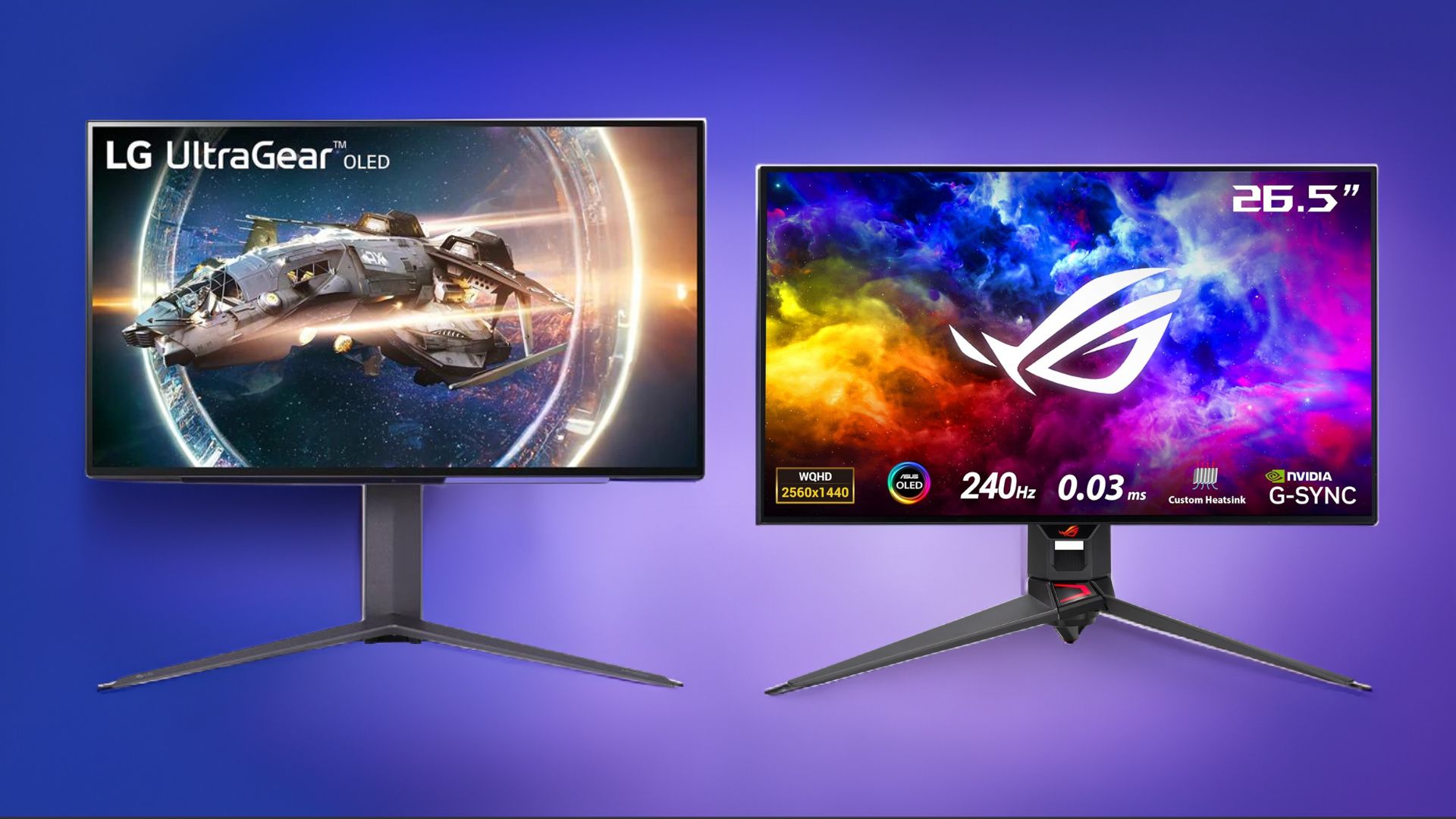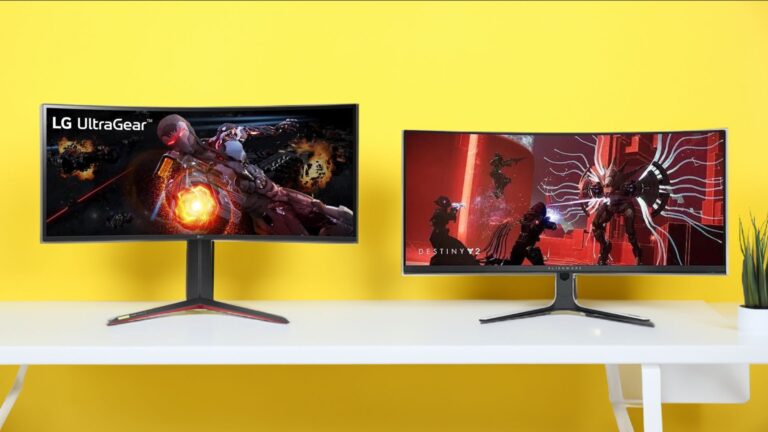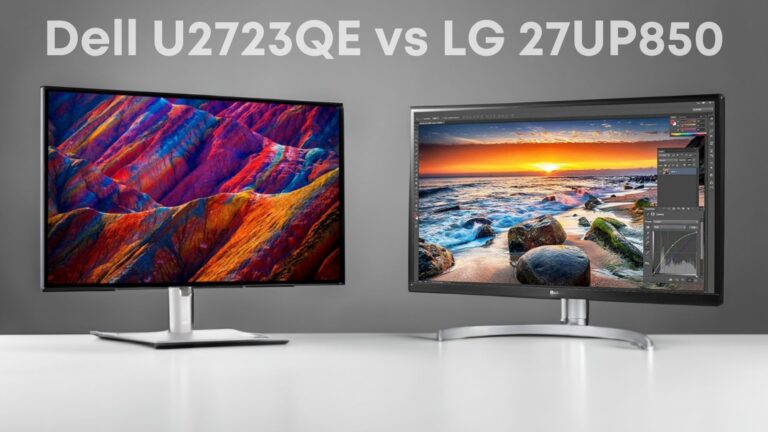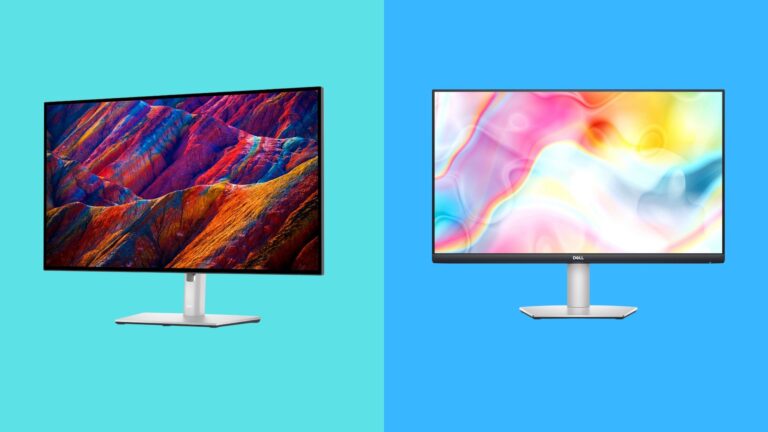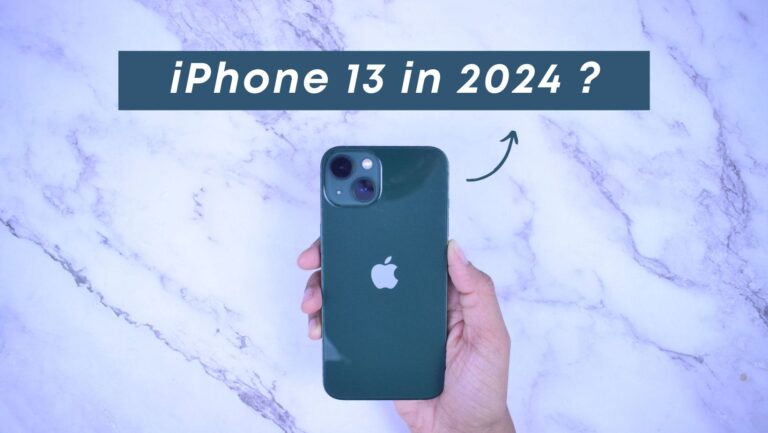These days, there are a lot of OLED monitor options available in the market, but today we are going to do a side-by-side comparison of the two best 27-inch OLED monitors, the ASUS ROG SWIFT PG27AQDM and the LG ULTRAGEAR 27GR95QE-B. Both of them have almost the same specs, yet the ASUS monitor is $100 more expensive than the LG monitor. So, should you spend the extra money on the PG27AQDM, or should you go with the 27GR95QE-B? I will explain everything in this article.
| Asus ROG Swift PG27AQDM | LG UltraGear 27GR95QE-B |
 |  |
| Check Price | Check Price |
Design & Build
Both of them have a very gamer-oriented design, with the thickness of the panels being only 5 mm, which looks very sleek. Behind the panels, you get a box for all the monitor’s components and ports. However, when you look at the bezels, the 27GR95QE-B has 8 mm on the top and sides, and 10 mm on the bottom, while the PG27AQDM has 9 mm on three sides and 11 mm on the bottom. But this difference is quite small, so you won’t notice a significant visual distinction.
The build quality of both of these is excellent, the plastic used in them is very sturdy, and if you look at their stands, both of them have metal stands that offer excellent support and stability to the monitor. Both of their stands look good, but I preferred the stand of the PG27AQDM more.
Because The PG27AQDM offers slightly better ergonomic adjustments compared to the 27GR95QE-B. In the PG27AQDM, you can tilt the screen between -17.5° and 5°, swivel it from -30° to 30°, and rotate it into portrait mode on both sides. On the other hand, the 27GR95QE-B allows for tilting between -15° and 5°, swiveling from -10° to 10°, and rotating into portrait mode only anticlockwise. However, both monitors have the same height adjustment range of 11 cm.
Both monitor stands also have metal legs, and they are quite wide, which allows both monitors to balance well on the desk. However, there is minimal wobble observed in the 27GR95QE-B. Additionally, they both have VESA 100×100 millimeter compatibility.
Both of them have excellent RGB implementation. They both have bright RGB lights at the back, especially the 27GR95QE-B, which has a lot of them. It even has a small RGB light in the middle of its bottom chin, and it offers options to change colors. The PG27AQDM has down-facing RGB lighting underneath its stand, and there’s another backlit ROG logo in the center at the bottom of the screen, which looks really awesome on the desk.
Cable management here is not the best, but it is good for clean setup. In the 27GR95QE-B, you get a clip on the stand to manage cables, and in the PG27AQDM, there is a gap between the stand.
Overall, both of them give a premium look and feel, which is expected because both of them come at a pretty high premium price.
Ports
Both of them have a pretty decent selection of ports. In the case of the PG27AQDM, the ports are located on the rear bottom side, facing downward. It includes 2 HDMI 2.0 ports, one DisplayPort 1.4 with DSC, a USB 3.2 Type B upstream port, two USB 3.2 Type-A downstream ports, and a 3.5mm audio out port.
On the 27GR95QE-B, the ports are located right at the bottom, where you attach the stand. For video connectivity, it offers one DisplayPort 1.4 and two HDMI 2.1 ports. For audio connectivity, it provides a digital audio out and a 3.5mm audio out with DTS Headphone X support. Additionally, it has two USB 3.0 Type-A ports and one USB 3.0 Type-B port for other peripheral connections.
It’s a bit strange that neither of them has a USB Type-C port, but let it be. So, if you want to do high-refresh rate gaming through HDMI with better audio, then 27GR95QE-B would be a good option for you. However, if you’re looking for advanced USB connectivity, you’ll find that in the PG27AQDM.
Display & Performance
As I mentioned at the beginning, both of these are 27-inch OLED monitors. Now, let me provide some details about their displays. Both monitors offer the same 1440p resolution, but they have different pixel densities. The PG27AQDM has a pixel density of 110 pixels per inch (PPI), while the 27GR95QE-B has a pixel density of 108 PPI.
Both of these screens come with a matte coating, which I personally didn’t like much because on an OLED panel, a glossy finish generally looks better. Due to this matte finish, there is a slight oily effect on the screen, which can be noticeable when playing games, especially in games with bright backgrounds.
The monitors boast a high refresh rate of 240 Hz, an incredibly fast response time of 0.3 milliseconds, and VRR (Variable Refresh Rate) technology like AMD FreeSync Premium. Additionally, both monitors have good input lag, with the PG27AQDM at 8.8 ms and the 27GR95QE-B slightly better at 2.9 ms. Because of these features, both monitors are capable of delivering exceptional performance in casual gaming as well as eSports gaming, all without experiencing screen tearing or ghosting issues.
If I talk about brightness, I was quite disappointed with the SDR brightness of both monitors. In the SDR mode of the 27GR95QE-B, I only got a peak brightness of 200 nits, whereas the PG27AQDM was able to provide 250 nits of peak brightness in SDR, which, while not very bright, is still better than what I experienced with the 27GR95QE-B.
But yes, when you turn on HDR mode for both of them, their HDR brightness looks very impressive, with the 27GR95QE-B reaching up to 600 nits and the PG27AQDM going up to 900 nits. That’s why I prefer playing with HDR mode enabled on both of them compared to their SDR mode.
if you’re playing a game that doesn’t support HDR, it might be a bit challenging due to the SDR brightness. If you want to play games without HDR, you’ll need to close your room’s curtains and turn off the lights so that you can experience the true black of OLED in them properly.
the 27GR95QE-B and PG27AQDM offer excellent color coverage, with both of them providing 100% sRGB colors, and the 27GR95QE-B offering 91% Adobe RGB while the PG27AQDM offers 92% Adobe RGB. However, due to the lower brightness of these monitors, you don’t get to see the colors in their full vibrancy.
The DCI-P3 color gamut is quite similar in both monitors. The 27GR95QE-B offers an outstanding 98% DCI-P3 color coverage, and the PG27AQDM is close behind with an impressive 97% DCI-P3 color coverage, which is fantastic. Additionally, both displays support 10-bit color depth.
Both of them offer excellent color accuracy, even without any calibration, because both come with factory calibration that is almost perfect. Speaking of average dE color accuracy, the 27GR95QE-B has 1.91, while the PG27AQDM has 2.8. Here, LG takes a significant lead.
If we set aside the brightness factor, both of them offer superb image quality, and they also come with the advantages of OLED panels, such as infinite contrast and deep black levels. These features provide an excellent and robust gaming experience.
For now, I would say that both the PG27AQDM and 27GR95QE-B monitors are not suitable for creative work. They can be used for fast-paced gaming, media consumption, and regular office tasks.
OSD Menu
I really liked the UI design of the menu system available in 27GR95QE-B because it is very beautiful, super user-friendly, clean and has fantastic graphics and animations.
To navigate the OSD menus on the 27GR95QE-B monitor, you don’t get a joystick. Instead, LG provides a separate remote control for it, which I didn’t find very appealing for a couple of reasons.
First, the joystick that used to be present on their previous Ultragear monitors was excellent and didn’t require any extra accessories. Second, the remote control for this monitor operates on battery power, whereas other monitor brands like Samsung provide a USB-C port to charge their remotes. However, the 27GR95QE-B doesn’t seem to have such a USB-C charging port.
But if we set aside the battery-related point, the rest of this remote works well. It’s responsive and there are no issues in that regard.
In comparison to the 27GR95QE-B, the PG27AQDM has a rather basic menu system, which is controlled using a joystick and two buttons. These controls are located at the bottom, just behind the backlit ROG logo.
In both of them, you will find options like brightness, contrast, presets, color adjustment, Adaptive Sync, input, and various other settings. So, you won’t find any significant differences in the menu system options between the two. Some options may have the same function but different names in both monitors, but you would discover that as you use them later on.
OLED Burn-In
So, will you encounter the problem of screen burn-in in these two or not, I won’t lie to you, but so far, there hasn’t been any technology developed that can completely solve the issue of screen burn-in in OLED displays. However, these monitors do have some features that significantly mitigate the issue of burn-in and slightly extend the lifespan of OLED monitors.
Both the 27GR95QE-B and PG27AQDM monitors offer features like screensaver, pixel cleaner, and screen move to reduce the problem of burn-in and image retention. Among these features, the screensaver function dims the brightness in the corners where the chances of burn-in are the highest.
The Pixel Cleaner feature displays a pixel cleaning reminder on the screen after every four hours of use. This process takes about 7 to 8 minutes to complete and starts after the monitor enters standby mode.
In the screen move feature, pixels slightly shift from their original positions, and this process is entirely unnoticeable.
Price Difference
Both monitors are slightly more expensive for 27-inch displays. The market price for both the 27GR95QE-B and PG27AQDM was originally $999. However, currently, the 27GR95QE-B is available at a discounted price of only $900, making it a better value for money option compared to the PG27AQDM.
Conclusion
Both the LG UltraGear OLED 27GR95QE-B and Asus ROG Swift OLED PG27AQDM monitors are fantastic options that allow you to experience the beauty of OLED technology. However, if I had to recommend one of them right now, I would suggest the 27GR95QE-B. It provides you with the same powerful features like a 240Hz refresh rate, 0.3 ms response time, better visual experience, wide color coverage, and Adaptive Sync at a lower price.
While the PG27AQDM does perform slightly better in some aspects compared to the 27GR95QE-B, it’s not significantly better to justify spending an extra $100 on it. However, if its price drops or if you can find it on sale for under $900, then it could become a more attractive option.
